Chemical Characterization of Red Pigments Used in Funerary Practices in Northeastern Patagonia (Chubut, Argentina) During the Late Holocene
Abstract
1. Introduction
2. Materials and Methods
2.1. Human Burial Sites
2.2. Samples Description
2.3. Analytical Methods
3. Results
3.1. XRF
3.2. XRD
3.3. FTIR ATR
4. Discussion
Author Contributions
Funding
Data Availability Statement
Acknowledgments
Conflicts of Interest
References
- Gómez Otero, J.; Dahinten, S. Costumbres funerarias y esqueletos humanos: Variabilidad y poblamiento en la costa nordeste de la provincia del Chubut (Patagonia argentina). Rel. Soc. Arg. Antrop. 1997–1998, XXII–XXIII, 101–124. [Google Scholar]
- Gómez Otero, J. Arqueología de la costa centro-septentrional de Patagonia. In Arqueología de la Costa Patagónica: Perspectivas para la Conservación; Cruz, I., Caracotche, M.S., Eds.; Universidad Nacional de la Patagonia Austral: Río Gallegos, Argentina, 2006; pp. 72–80. [Google Scholar]
- Stern, C.R. Obsidian sources and distribution in Patagonia, southernmost South America. Quatern. Int. 2018, 468, 190–205. [Google Scholar] [CrossRef]
- Banegas, A.; Gómez Otero, J.; Pérez, A.E. Circulación y uso de obsidianas en la costa norte del golfo San Jorge (provincia de Chubut, Argentina) durante el Holoceno tardío: Primeros resultados. Arqueología 2021, 27, 193–206. [Google Scholar] [CrossRef]
- Goye, M.S.; Pérez, A.E.; Gómez Otero, J. Circulación de obsidiana en el valle inferior y desembocadura del Río Chubut (Patagonia argentina) durante el Holoceno tardío. Cuad. Inst. Nac. Antropol. Pensam. Latinoam. 2024, 11, 212–231. [Google Scholar]
- Gurin, C.; Mazzuca, M.; Gómez Otero, J.; Maier, M.S. Micro-Raman spectroscopy and complementary techniques applied for the analysis of rock art paintings at the archaeological locality La Angostura, lower valley of Chubut River (Patagonia, Argentina). Archaeol. Anthrop. Sci. 2021, 13, 54. [Google Scholar] [CrossRef]
- Politis, G.G.; Barrientos, G.; Scabuzzo, C. Los entierros humanos de Arroyo Seco 2. In Estado Actual de las Investigaciones en el Sitio Arqueológico Arroyo Seco 2, Partido de Tres Arroyos, Provincia de Buenos Aires, Argentina, 1st ed.; Politis, G., Gutiérrez, M.A., Scabuzzo, C., Eds.; Facultad de Ciencias Sociales, Universidad Nacional del Centro de la Provincia de Buenos Aires: Tandil, Argentina, 2014; pp. 329–369. [Google Scholar]
- Scheinsohn, V.; Dahinten, S.L.; Gómez Otero, J.; Rizzo, F.; Leonardt, S.; Tchilinguirián, P.; Millán, A.G.; Kuperszmit, N.; Carpio González, M.; Beroqui, B. La antigüedad de la ocupación humana en el centro-oeste del Chubut: Nuevos datos del valle del Genoa. Arqueología 2017, 23, 109–124. [Google Scholar]
- Gómez Otero, J.; Banegas, A.; Caruso Fermé, L.; Goye, M.S.; Millán, A.G.; Schuster, V.; Svoboda, A.; Weiler, N. Los primeros pobladores humanos: Arqueología de la Bajada Colombo. In Reserva de Vida Silvestre San Pablo de Valdés 10 años: Conservando el Patrimonio Natural y Cultural de la Península Valdés Patagonia Argentina, 1st ed.; Udrizar Sauthier, D.E., Pazos, G.E., Arias, A.M., Eds.; Fundación Vida Silvestre: Buenos Aires, Argentina, 2017; pp. 230–265. [Google Scholar]
- Bird, J.B. Travels and Archaeology in South Chile, 1st ed.; University of Iowa Press: Iowa City, IA, USA, 1988; pp. 1–278. [Google Scholar]
- L’Heureux, G.L.; Amorosi, T. El entierro del sitio Cerro Sota (Magallanes, Chile) a más de setenta años de su excavación. Magallania 2010, 38, 133–149. [Google Scholar] [CrossRef]
- Franco, N.V.; Guarido, A.L.; Montenegro, T.; Ambrústolo, P. Variabilidad en la utilización de pigmentos en entierros humanos del Holoceno tardío en la cuenca superior del Río Santa Cruz (Patagonia Argentina). Bol. Mus. Chil. Arte Precolomb. 2012, 17, 11–25. [Google Scholar] [CrossRef]
- Ozán, I.L.; Oriolo, S.; L’Heureux, G.L.; Schmidt, B. Minerales para los muertos: Yeso y hematita en entierros prehispánicos de Patagonia meridional. Rev. Asoc. Geol. Argent. 2020, 77, 260–270. [Google Scholar]
- Bezur, A.; Lee, L.; Loubser, M.; Trentelman, K. Handheld XRF in Cultural Heritage. In A Practical Workbook for Conservators; The Getty Conservation Institute: Los Angeles, CA, USA, 2020; pp. 1–191. [Google Scholar]
- Derrick, M.R.; Stulik, D.; Landry, J.M.K. Infrared Spectroscopy in Conservation Science; The Getty Conservation Institute: Los Angeles, CA, USA, 1999; pp. 1–235. [Google Scholar]
- Ali, A.; Chiang, Y.W.; Santos, R.M. X-ray Diffraction Techniques for Mineral Characterization: A Review for Engineers of the Fundamentals, Applications, and Research Directions. Minerals 2022, 12, 205. [Google Scholar] [CrossRef]
- Súnico, A.; Bouza, P.; Del Valle, H. Erosion of Subsurface Horizons in Northeastern Patagonia, Argentina. Arid Soil Res. Rehabil. 1996, 10, 359–378. [Google Scholar] [CrossRef]
- Bayón, C.; Martínez, G.A.; Armentano, G.; Scabuzzo, C. Arqueología del valle inferior del río Colorado. El sitio La Primavera. Intersecc. Antropol. 2004, 5, 39–53. [Google Scholar]
- Gómez Otero, J. La importancia de rescatar los enterratorios humanos en riesgo: Experiencias en el nordeste de la provincia del Chubut (Argentina). Rev. Arqueol. 2012, V, 15–33. [Google Scholar]
- Macbeth Division of Kollmorgen Instruments Corporation. Munsell® Soil Color Charts; Macbeth Division of Kollmorgen Instruments Corporation: New Windsor, NY, USA, 1994. [Google Scholar]
- Picuri, J.C.; Natoli, J.M.; Shaw, S.E.; Shyam, S.P.; VanHoesen, S.R.; Lin, Z.; Bowyer, W.J. Can X-ray diffraction distinguish natural from anthropogenic hematite? Replication of the conversion of natural goethite in both furnace and campfire. Colorants 2022, 1, 363–375. [Google Scholar] [CrossRef]
- Ghosh, S.; Roy, S.; Bardhan, S.; Khatura, N.; Bhowal, B.; Chanda, D.K.; Das, S.; Mondal, D.; Basu, R.; Das, S. Effect of size fractionation on purity, thermal stability and electrical properties of natural hematite. J. Electron. Mater. 2021, 50, 3836–3841. [Google Scholar] [CrossRef]
- Hurbut, C.S., Jr. Manual de Mineralogía de Dana, 2nd ed.; Editorial Reverté: Barcelona, Madrid, 1981; pp. 514–515. [Google Scholar]
- Hudson Institute of Mineralogy. Available online: https://www.mindat.org/min-1155.html (accessed on 25 September 2025).
- Massaferro, G.I.; Arrigoni, G.I.; Boschín, M.T.; Fernández, M.M.; Crivelli, E.A.; Cordero, J.A. Indicadores de tecnología y etnodinamia: El análisis de pigmentos en el Paraje Arqueológico Comallo Arriba, provincia de Río Negro, Argentina. Bol. Mus. Chil. Arte Precolomb. 2012, 17, 117–127. [Google Scholar] [CrossRef]
- Bikiaris, D.; Daniilia, S.; Sotiropoulou, S.; Katsimbiri, O.; Pavlidou, E.; Moutsatsou, A.P.; Chryssoulakis, Y. Ochre-differentiation through micro-Raman and micro-FTIR spectroscopies: Application on wall paintings at Meteora and Mount Athos, Greece. Spectrochim. Acta A 2000, 56, 3–18. [Google Scholar] [CrossRef] [PubMed]
- Shoval, S.; Champagnon, B.; Panczer, G.J. The quartz-cristoballite transformation in heated chert rock composed of micro and crypto-quartz by Micro-Raman and FTIR spectroscopy methods. J. Thermal Anal. 1997, 50, 203–213. [Google Scholar] [CrossRef]
- Darchuk, L.; Tsybrii, Z.; Worobiec, A.; Vázquez, C.; Palacios, O.M.; Stefaniaak, E.A.; Gatto Rotondo, G.; Sizor, F.; Van Grieken, R. Argentinian prehistoric pigments’ study by combined SEM/EDX and molecular spectroscopy. Spectrochim. Acta A 2010, 75, 1398–1402. [Google Scholar] [CrossRef] [PubMed]
- Chukanov, N.V.; Chervonnyi, A.D. Infrared Spectroscopy of Minerals and Related Compounds; Springer: Berlin/Heidelberg, Germany, 2016. [Google Scholar]
- De Benedetto, G.E.; Laviano, R.; Sabbatini, L.; Zambonin, P.G. Infrared spectroscopy in the mineralogical characterization of ancient pottery. J. Cult. Herit. 2002, 3, 177–186. [Google Scholar] [CrossRef]
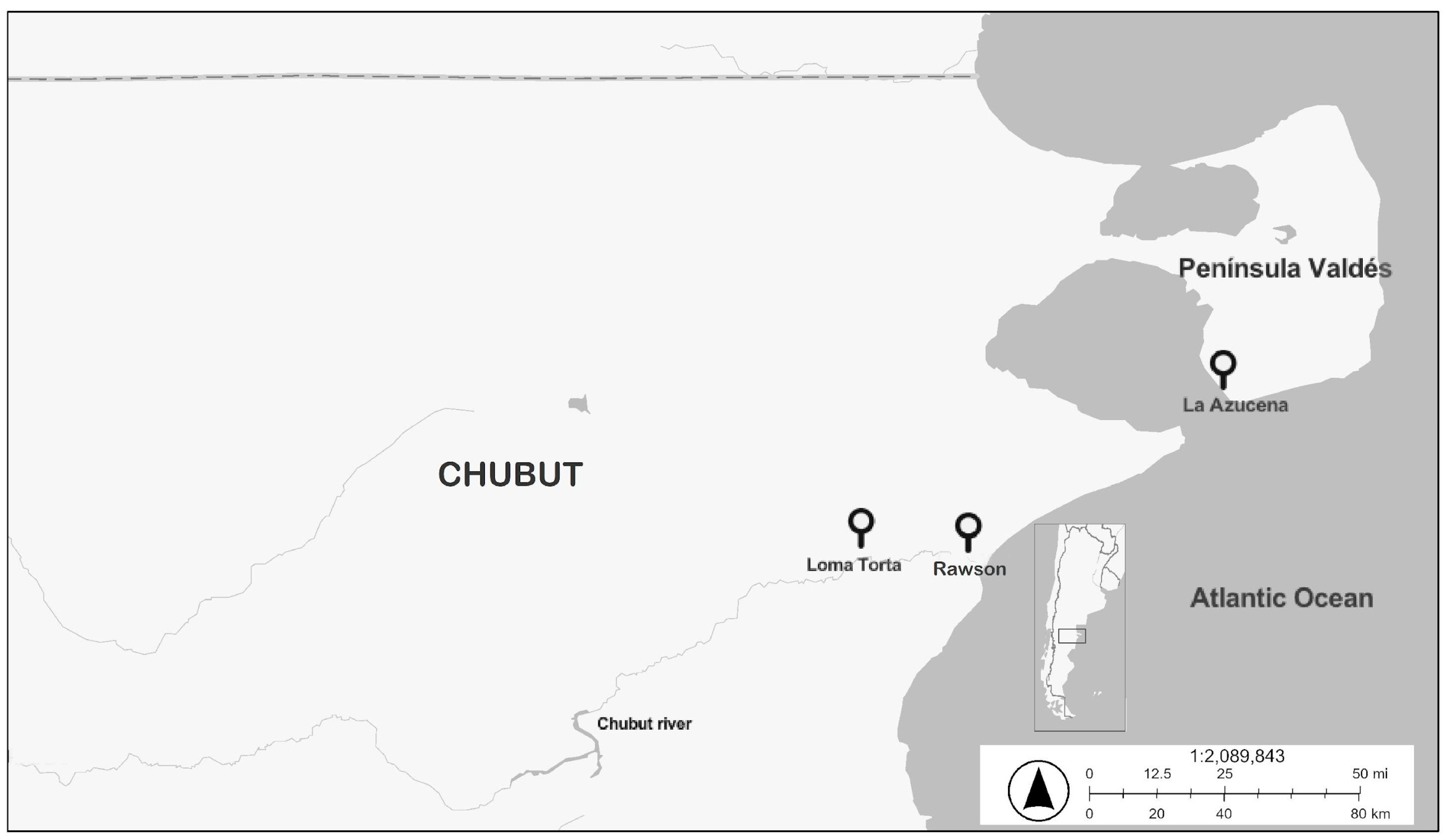

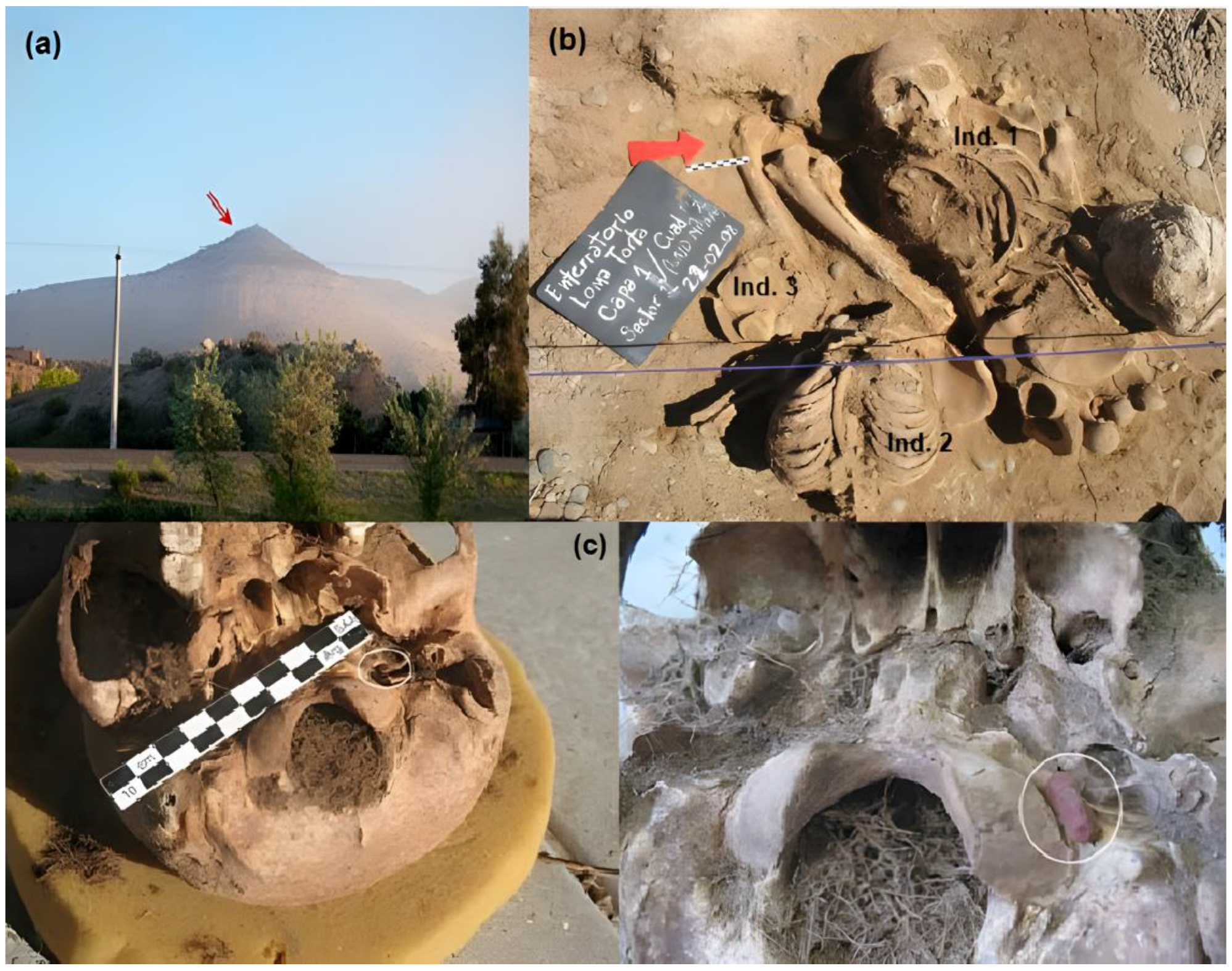
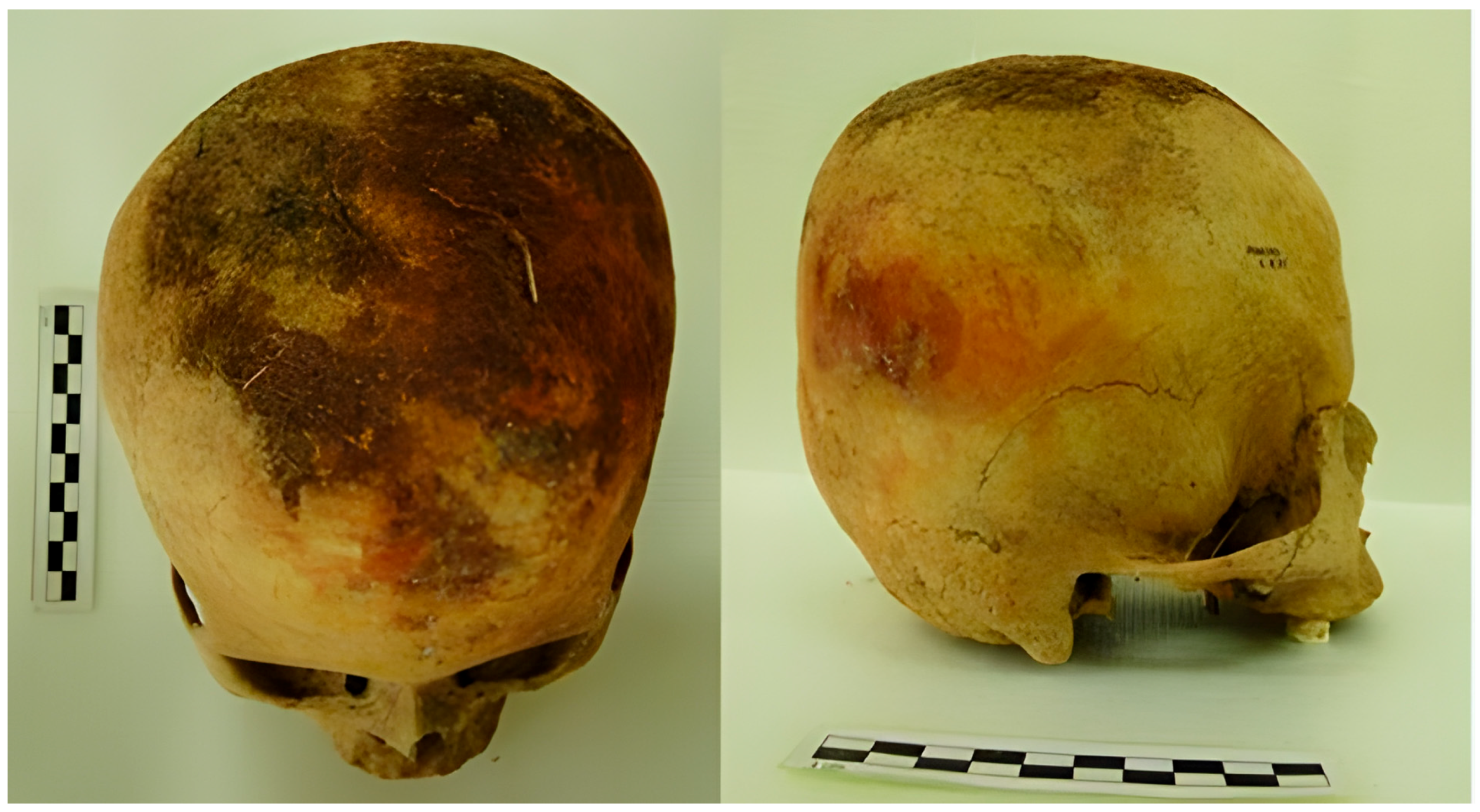
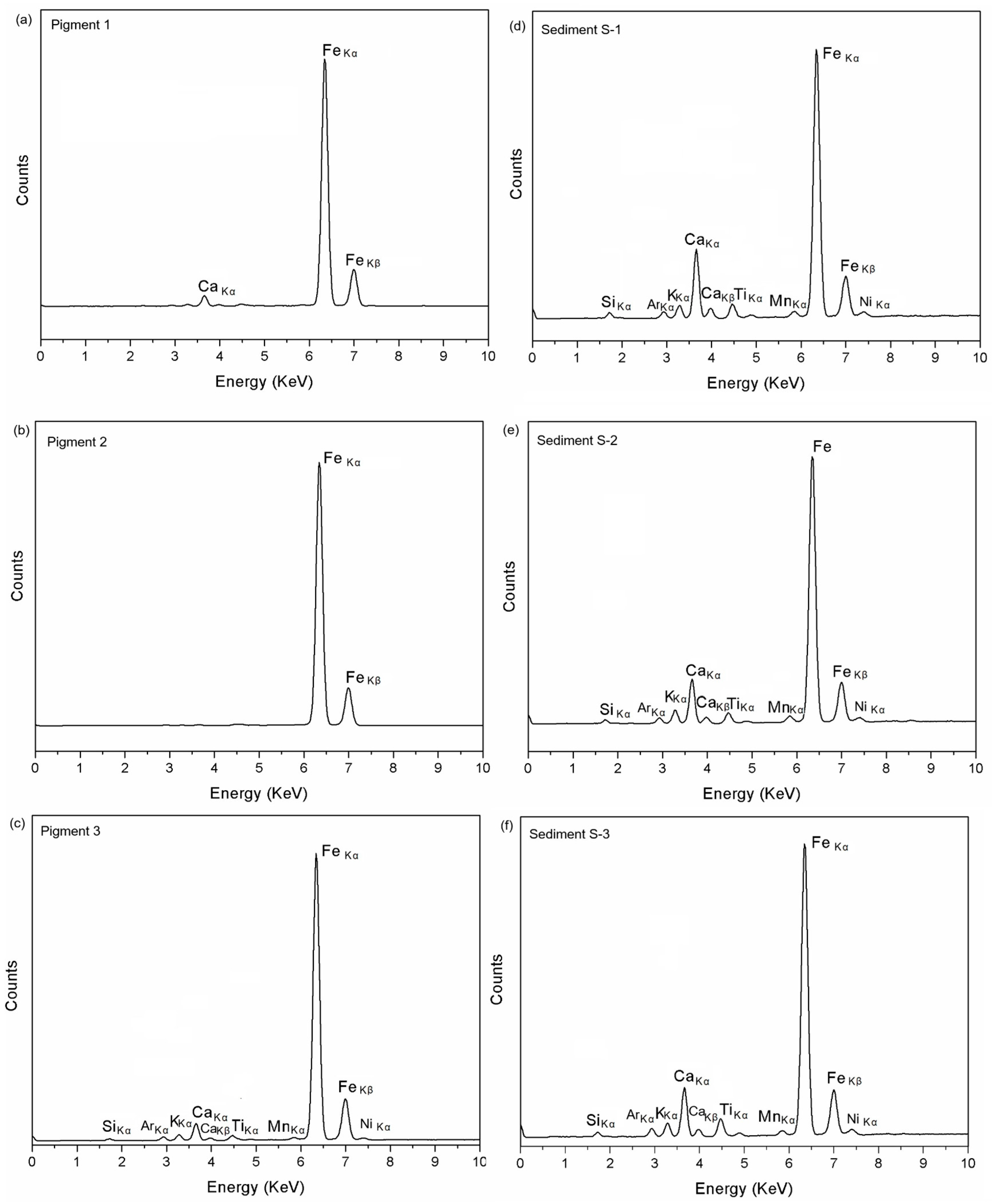
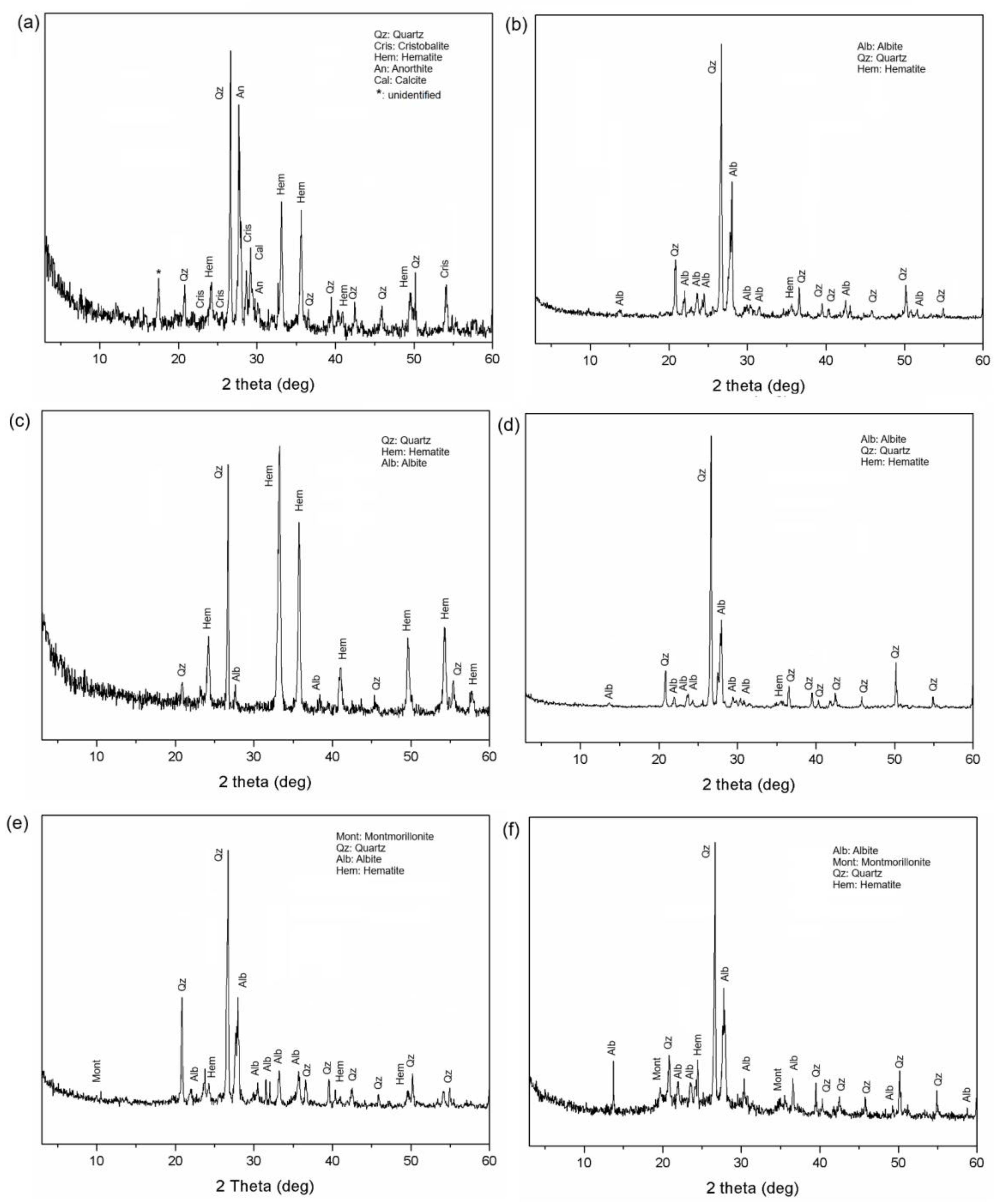

| Burial Site, Geoposition | Sample | Color, Munsell |
|---|---|---|
| La Azucena 1 | 1 | Red (10R 5/8) |
| 42°50′43″ S/64°09′82″ W | S1 | Reddish brown (2.5YR 4/4) |
| Loma Torta | 2 | Red (10R 5/8) |
| 43°16′36.7″ S/65°0.5′51.5″ S | S2 | Reddish brown (2.5YR 4/4) |
| Rawson | 3 | Dark red (10R 3/6) |
| 43°17′19.6″ S/65°05′51.5″ W | S3 | Brown (7.5YR 5/7) |
| Sample | XRD | XRF | ATR-FTIR |
|---|---|---|---|
| 1 | Quartz, cristobalite, anorthite, calcite, hematite | Fe, Ca | Quartz, aluminosilicates, calcite, hematite |
| S-1 | Quartz, albite, hematite (minor) | Si, K, Ca, Ti, Mn, Fe | Quartz, aluminosilicates, calcite, hematite |
| 2 | Quartz, hematite, albite (minor) | Fe | Quartz, aluminosilicates, hematite |
| S-2 | Quartz, albite, hematite (minor) | Si, K, Ca, Ti, Mn, Fe | Quartz, aluminosilicates |
| 3 | Quartz, albite, montmorillonite, hematite | Si, K, Ca, Ti, Mn, Fe | Quartz, aluminosilicates, hematite |
| S-3 | Quartz, albite, montmorillonite, hematite (minor) | Si, K, Ca, Ti, Mn, Fe | Quartz, aluminosilicates |
Disclaimer/Publisher’s Note: The statements, opinions and data contained in all publications are solely those of the individual author(s) and contributor(s) and not of MDPI and/or the editor(s). MDPI and/or the editor(s) disclaim responsibility for any injury to people or property resulting from any ideas, methods, instructions or products referred to in the content. |
© 2025 by the authors. Licensee MDPI, Basel, Switzerland. This article is an open access article distributed under the terms and conditions of the Creative Commons Attribution (CC BY) license (https://creativecommons.org/licenses/by/4.0/).
Share and Cite
Gurin, C.; Mazzuca, M.; Gómez Otero, J.; Maier, M.S. Chemical Characterization of Red Pigments Used in Funerary Practices in Northeastern Patagonia (Chubut, Argentina) During the Late Holocene. Minerals 2025, 15, 1055. https://doi.org/10.3390/min15101055
Gurin C, Mazzuca M, Gómez Otero J, Maier MS. Chemical Characterization of Red Pigments Used in Funerary Practices in Northeastern Patagonia (Chubut, Argentina) During the Late Holocene. Minerals. 2025; 15(10):1055. https://doi.org/10.3390/min15101055
Chicago/Turabian StyleGurin, Celeste, Marcia Mazzuca, Julieta Gómez Otero, and Marta S. Maier. 2025. "Chemical Characterization of Red Pigments Used in Funerary Practices in Northeastern Patagonia (Chubut, Argentina) During the Late Holocene" Minerals 15, no. 10: 1055. https://doi.org/10.3390/min15101055
APA StyleGurin, C., Mazzuca, M., Gómez Otero, J., & Maier, M. S. (2025). Chemical Characterization of Red Pigments Used in Funerary Practices in Northeastern Patagonia (Chubut, Argentina) During the Late Holocene. Minerals, 15(10), 1055. https://doi.org/10.3390/min15101055








